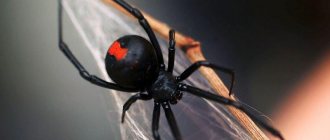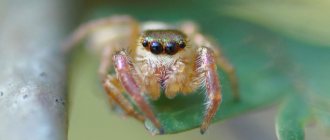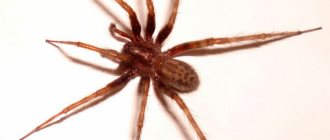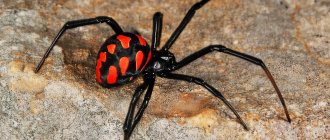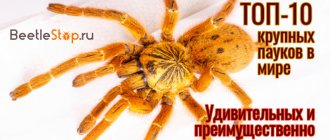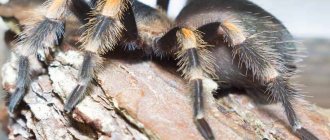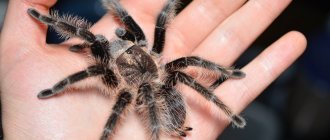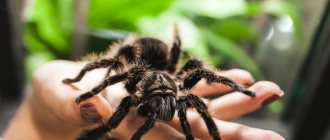Spiders are the most numerous order in the class of arachnids. It contains 4076 genera and 46986 species (as of November 2022). Spiders are not insects ; according to the taxonomic hierarchy, they are arthropods .
Unlike insects, spiders do not have antennae. They have 6 pairs of limbs. 8 of them are walking legs. In front there are 2 chelicerae with ducts of poisonous glands. To the side of them are the pedipalps, the simplest sensory organs. The head and thorax of the spiders are fused. The cephalothorax and abdomen (opisthosoma) are connected by a thin constriction. There are 2-8 paired arachnoid warts on the abdomen. The tarsi are covered with trichobothria (setae), sensitive to air vibrations.
They eat mainly insects. Spiders have a narrow esophagus. Therefore, they digest food externally. They inject an enzyme into the prey. After a few hours, they drink the insides, which have turned into nutritious juice.
They live on all continents except Antarctica. Their hypodermis produces a chitinous cuticle that prevents moisture evaporation. Therefore, spiders successfully survive in dry areas. The largest representatives can be found in hot places. All spiders are terrestrial animals. The silverback spider is the only species that lives in water. There are also individuals that hunt on the surface of the water.
The main predecessors of modern spiders formed 200 million years ago in the Triassic (the first part of the Mesozoic era). Arachnids capable of producing webs appeared in the Devonian period (386 million years ago).
External structure
External structure of a spider
Spiders are heterosexual, and in most species the males are smaller than the females. This is due to the fact that when creating offspring of a female, it is then easier to eat the partner and produce more cubs. At the back are the warts, from which the warts stand out.
Body
The body consists of a cephalothorax covered with chitin, a hard exoskeleton. During its life, it can be updated up to 10 times, and the old one is reset only after a new one is formed under it.
Limbs
Spiders have four pairs of legs covered with small hairs.
There are also two pedipalps on the body, which are responsible for the sense of smell. Next to the jaws there are also chelicerae, with the help of which the predator injects poison into the prey. Interesting fact : thanks to the hairs on its limbs, the spider senses the direction of the wind and orients itself in space.
Color
The main components that determine the spider's color are bilin and guanine. They add brown and white to the body respectively. Also, other shades appear due to the light reflection characteristics of the hairs on the body.
Place in nature
Spiders are a significant and irreplaceable part of the ecosystem. They are of great importance, performing important functions:
- by feeding on a variety of insects, they regulate their numbers;
- They themselves are food for many animals.
Among those who eat spiders are:
- insects (mantises, blackbirds, scolopendras, wasps);
- spiders (representatives of some species feed on their own kind);
- reptiles (snakes, lizards);
- amphibians (toads, frogs);
- small mammals (hedgehogs, rats, mice, noses).
And, of course, birds feed on spiders, for some of which arachnids are their main food.
Internal structure
Internal structure of a spider
Spiders have a complex internal structure, and several systems continuously function in their bodies.
central nervous system
Consists of the nervous system and brain. The latter is a collection of ganglia. It is responsible for the functioning of the eyes and perception of the environment. The spider's brain is developed enough to analyze and act not only on instincts, but also on existing experience.
Circulatory system
This system is not closed. The heart is located inside the abdominal cavity; the role of its valves is performed by stomata, which close during pulsations. The circulatory system runs through the entire body and into the limbs.
Digestive system
In the process of eating food, the spider's digestive system begins to work. When a predator pulls fluid from its prey, it ends up in the foregut. In it, part of the liquid is absorbed into the walls, and the rest is transported to the stomach. Spiders also have a liver, which is responsible for breaking down food particles.
Metallic arboreal tarantula
The huge electric blue tarantula is rightfully considered one of the most beautiful spiders on the planet. It is often kept in home terrariums; many exotic lovers dream of getting such a miracle.
However, we would not recommend that you buy such a non-standard pet. The metal tree tarantula is very poisonous, and its bite can cause not only unbearable pain, but also lead to such unpleasant consequences as arrhythmia, tachycardia, disorientation, convulsions and tumors. No fatalities from the bite have ever been recorded.
Reproduction
Female with spiderlings
The mating season for spiders begins in autumn and lasts until spring. At this time, the male goes in search of the female. Having found a suitable candidate, he begins to perform a special dance that attracts attention. If the female reciprocates, then they retire. After this, the male moves away, and the female begins to wait for offspring. After two and a half months, she lays eggs, and after another month, the young hatch from them.
Argiope Brünnich
People call these beautiful creatures “wasp spiders.” These are medium-sized spiders - the body length can slightly exceed three centimeters in females. Males of Argiope Brünnich are very small - about five millimeters.
Females of this species are easy to recognize due to their outstanding external characteristics - a striped yellow-black abdomen and very long legs. But the males are completely unremarkable - black or gray.
How long do spiders live?
The lifespan of spiders depends on the species. On average they live for several years. Large spiders are considered long-lived. For example, tarantulas can survive for 10-12 years. Females live approximately twice as long as males. The body of the latter begins to age sharply after puberty.
Interesting fact : the record for life expectancy belongs to the female of the species Gaius Villosus: 43 years.
Distribution and habitats
Spiders can live even where other living things cannot live. They are distributed over all continents and islands, with the exception of areas that are covered with ice all year round. The vast majority of spiders build burrows, nests and other shelters, but some species do not have a permanent habitat.
In nature
How do they breathe
Respiratory system of spiders
Depending on the species, spiders may have the following variations of the respiratory system:
- one pair of lungs;
- two pairs of lungs;
- a pair of lungs and a pair of tracheas;
- pairs of sieve and tubular tracheas;
- pair of sieve tracheas.
Getting inside the spider through special holes, oxygen is transported through the hemolymph to the respiratory organs with the help of hemocyanin. The lung sacs are located in the front of the abdomen. They saturate the body with oxygen through the circulatory system. Also behind the pulmonary sacs are bundles of tracheae, which are small tubes. They exit through a single breathing hole. During exhalation, the spider releases the resulting carbon dioxide into space.
Eresus
These are very small spiders - their body length is rarely more than one centimeter. Eresus males have a red-orange abdomen with black spots, and females, alas, do not have an unusual color. Males often have white rings on their legs.
Eresus dig deep holes underground, in which they set up their own home. They hunt flies, butterflies, and beetles.
The bite of these spiders is very toxic and can even be fatal. Unfortunately, these beautiful but dangerous spiders are quite common in our country.
How do they winter
Some spiders can lead an active lifestyle in winter.
Spiders are able to hibernate in different ways. Some survive frosts in the foliage and bark of trees. Spiders also try to escape the cold by settling in different buildings. In the cold, the predator produces a special chemical that acts as antifreeze. If a female lays eggs before the onset of cold weather, she tries to hide them in a secluded place where the temperature will still remain above zero in the winter.
Interesting fact : in the cold, spiders fall into a state similar to suspended animation. Because of this, processes in the body slow down and they age more slowly.
Maratus personatus
This is probably the cutest spider on the planet. We're willing to bet that these amazing creatures can make even the most ardent arachnophobe smile.
These furry babies do not grow more than five millimeters. But small sizes and non-standard colors are not all of their advantages.
The most beautiful thing about these spiders is the way the males court the females. They perform amazing dances, lifting their paws up - believe me, it looks very funny.
How many eyes does a spider have?
Spider Eyes
The number of spider eyes varies from 2 to 12 depending on the species, but in most cases there are 8. They are located in such a way that the creature's viewing radius is 360 degrees. Spiders see what is happening around them at about 30 cm. The main task of the visual organs is to notice in time the approach of prey or danger. Also, some types of spiders can distinguish between colors.
In the center of the head is the main pair of eyes, which are larger than the others. With their help, the spider focuses on objects. The lateral eyes are motionless and are needed for additional visibility.
Other arachnids
Central Asia and Africa are home to large arthropods, which are unknowingly confused with spiders. In fact, these are salpugs or, as they are also called, camel spiders. Unlike spiders, these living creatures do not have poisonous glands or glands for creating webs, but they are armed with teeth.
Spiders cause a feeling of fear in many people, but this is more likely due to ignorance. In fact, these are quite harmless living creatures.
10 Most Amazing Spiders in the World
Are spiders insects or not? Difference between spiders and insects
Spider and Beetle
Spiders are not insects. Despite the fact that they also belong to the type of arthropods, they have a number of differences:
- Spiders have four pairs of limbs, and insects have three;
- spiders have chelicerae with which they inject venom into their prey;
- the head of insects is clearly defined, and in spiders it is combined with the body;
- Insects have only one pair of eyes;
- all types of spiders (with rare exceptions) lead a predatory lifestyle and do not eat plants;
- spiders breathe using pulmonary sacs, and insects use only tracheas;
- Insects have antennae on their heads.
Also, one of the main differences between spiders and insects is the ability to weave webs.
Interesting classification
Everyone knows that there are lovers of large tarantulas who classify their pets according to their speed characteristics. For example:
- For Dummies". These are slow-moving representatives of this species that many people like to film. They can sit quietly in your hand and move very slowly.
- For the “advanced”. These arthropods move quite quickly, so they are unlikely to be photographed.
- For professionals. They move so fast that you almost don't notice in which direction the arthropod has disappeared.
Given these speed characteristics, it is not difficult to guess how many species are still unknown to mankind.
Harmless species of spiders
If the spider's venom is mildly toxic and causes almost no harm to humans, such species are considered harmless and non-poisonous. There are a large number of species in the world, and the main ones are listed below.
Hunter bordered
Border hunter
Lives in swamps and places with high humidity. To hunt, it enters the water and waits for insects and other small creatures to swim nearby on the surface. Feeling the vibrations, the spider breaks away and runs towards the source of the waves to grab its prey. The hunter's length grows up to 2.3 cm, the paw span reaches 8 cm.
Flower spider
Flower Spider
The spider has long front legs that can effectively grab prey. Males grow up to 4 mm in length, and females grow up to 9 mm. Females are white, sometimes with a yellow tint on their paws. Males are brown with red spots.
Interesting fact : the spider lives in the buds of different flowers, and its color can change depending on the color of the leaves. This helps to remain invisible while hunting insects.
Knitting spiders
Knitting spiders
Representatives of this species live in fields and prefer to settle near a water source. They spread their nets between branches over a river or pond and wait for various insects to get there. Knitting spiders mainly prefer flies, ants and aphids. Adults stretch up to several millimeters in length.
Haymaker
The Harvesting Spider
has a small round body and long thin legs. The color can be dark brown or with a reddish tint. The haymaker lives both in nature and in residential buildings. Builds webs in well-lit places, because... loves sunlight. Hunts small insects, but can also eat plant foods. It is completely harmless to humans.
Goliath tarantula
Goliath tarantula
An adult can grow up to 30 cm, making this species one of the largest among spiders. The body is covered with hairs, the color varies from light brown to dark colors. Most of the population lives in South America. The goliath tarantula is often kept as a pet. It feeds on insects and other spiders.
Interesting: Bumblebee

